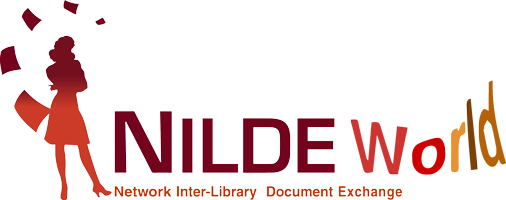You are here
How does NILDE works? How are requests processed in NILDE?
NILDE supports the entire work flow of ILL requests, starting from a patron request to their library, and ending with patron notification of delivery by the library. In between there is the Inter-Library Loan process between the requesting library and one or more lending libraries. Not all libraries use the full available NILDE functionalities: in fact, they may use NILDE only to manage the ILL process between libraries, without managing end-users requests, or managing them elsewhere. At present, there are about 50 thousands NILDE end-users which are registered at their libraries (83% are academic users, 11% are at health research institutions, 3% are at other public research institutions).
A sample work flow could be the following: a patron discovers a bibliographic reference in any of the library resources, let’s say they find it in a bibliographic database, or in library discovery tool. These must have been configured in order to make the request to the ILL service smooth. Usually a “Request by NILDE” button or a library link resolver button will be available and it will send request to NILDE via OpenURL. NILDE will ask the patron for authentication. Patron may select “federated authentication”, using single-sign on. It means they will be redirected to their Institutional Identity provider for authentication (of course, NILDE supports traditional on-site authentication too, it means patron has their own NILDE credentials). After logged in NILDE, patron sends the ILL request with just one click: in fact the request is already filled with complete bibliographic data.
ILL librarians will manage all user requests through their NILDE borrowing panel. For each request NILDE will automatically query all the connected catalogs through Z39.50, looking for suppliers. Libraries holding the specific item will be displayed for each union or virtual catalog. The order supplier libraries are displayed is based on a “ranking” algorithm. There is no automatic sending of the ILL request at this stage (unlike in other ILL systems): librarian will select a supplier library, with just one click. The ranking algorithm calculates on the fly the imbalance between borrowing and lending requests issued/received by each library in the current year. Libraries with the highest imbalance are shown on top of the list. Rank suggests the most suitable library to receive a borrowing request, to help that library equilibrate any imbalance (and to better distribute requests in the overall system). However, the requesting library is free to choose the preferred supplier.
The selected library receives the request; ILL librarians will manage it through their NILDE lending panel. If a link resolver has been configured, librarians may verify if the item is in their holdings with just one click, and directly access to it in case of an electronic item. The “Find licenses” button will help to find the proper license for that e-item; if a license is found and selected (among a list of licenses), NILDE will apply the license restrictions (or no restrictions if there aren’t) and let librarians fulfill the request according to them, either selecting the NILDE SEDD module to upload the file, or selecting another traditional transmission method (mail or fax or other e-systems, like Ariel etc..). In case of SEDD, NILDE starts processing the uploaded file behind the scenes, performing the Digital Hard Copy. This processing will usually take a few minutes.
Request fulfillment, or un-fulfillment, will be notified to the requesting library in their NILDE borrowing panel, and also via e-mail. If SEDD transmission has been used, librarian may open the file and print it directly from the NILDE interface; then notifies patron that article has been received and available at the library or in the internal mailing system. This ends the process.
